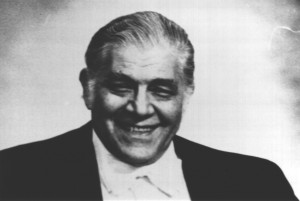 Arnold Jacobs claims to play two tubas at once, and does. As he says, he plays the tuba in his hands and the tuba in his head. Focusing the act of performance on the stimulus provided by the musical imagination is the key to the latter part of the famous Jacobs saying “Wind and Song.” To put it simply, he advocates that one sing a song in ones head while playing. “Make a statement!” he would admonish his class, Don’t ask questions!†Stating that brass instruments are “stupid”, he relates that one can only get out of a brass instrument what one puts into it. Unlike a piano-which one could approach with the question “What note is this?” then touch that key and receive a discrete and definitive answer-a brass instrument is liable to give any number of pitches depending on the input of the performer.
Arnold Jacobs claims to play two tubas at once, and does. As he says, he plays the tuba in his hands and the tuba in his head. Focusing the act of performance on the stimulus provided by the musical imagination is the key to the latter part of the famous Jacobs saying “Wind and Song.” To put it simply, he advocates that one sing a song in ones head while playing. “Make a statement!” he would admonish his class, Don’t ask questions!†Stating that brass instruments are “stupid”, he relates that one can only get out of a brass instrument what one puts into it. Unlike a piano-which one could approach with the question “What note is this?” then touch that key and receive a discrete and definitive answer-a brass instrument is liable to give any number of pitches depending on the input of the performer.
Of the three components of musical sound-vibration, motor activity, and resonance-a brass instrument provides only resonance, whereas a piano provides all but motor activity. Thus the tune (or vibration), must originate from the brain of the player in the form of pitch, and not just valve combination or slide position. Students can achieve this by practicing buzzing on a mouthpiece or by literally singing the melody they are about to perform. In addition to ones mind holding the goal of excellent musical performance, it must contain a sense of pitch which can overcome the inherent “stupidity” of a hunk of brass as well.
A study of the teaching and learning techniques of Arnold Jacobs finds them to be as innovative and inspiring as they are effective. Since much of his pedagogy deals with the process of acquiring new habits, Mr. Jacobs has utilized several psychological processes in altering stimuli to achieve desired responses. Believing that one can learn more rapidly and more comprehensively when as many of ones faculties are brought to bear as possible, Mr.  Jacobs favors a multi-sensory approach to learning. Careful to direct the flow of multi-sensory input, Arnold Jacobs emphasizes that students should focus upon their performance rather than themselves, emphasizing product rather than process. Though exaggeration is a popular tool for many teachers, Mr. Jacobs uses it to his advantage to make clear distinctions between subtle variances. In addition to all of these insightful approaches, he applies his warm and caring manner, devoted attention, and considerable charisma to each student.
Jacobs favors a multi-sensory approach to learning. Careful to direct the flow of multi-sensory input, Arnold Jacobs emphasizes that students should focus upon their performance rather than themselves, emphasizing product rather than process. Though exaggeration is a popular tool for many teachers, Mr. Jacobs uses it to his advantage to make clear distinctions between subtle variances. In addition to all of these insightful approaches, he applies his warm and caring manner, devoted attention, and considerable charisma to each student.
“Once something is learned, it is learned forever,” is a concept that Mr. Jacobs uses to begin his explanation of alternate learning habits. Citing that it is better to form a new correct habit than try to alter an old, bad one, Mr. Jacobs says that a previously  conditioned response will persist unless the stimulus which elicits it is altered. “Strangeness is good,” is the beginning of the process in which a student is made unsure by something different in approach, sensation or activity. It is this strangeness, or altered stimulus, which is then used to elicit the desired response, sidestepping the previously conditioned incorrect response.
conditioned response will persist unless the stimulus which elicits it is altered. “Strangeness is good,” is the beginning of the process in which a student is made unsure by something different in approach, sensation or activity. It is this strangeness, or altered stimulus, which is then used to elicit the desired response, sidestepping the previously conditioned incorrect response.
For example, in order to change the preconditioned responses elicited in a student when playing his or her instrument, Mr. Jacobs will simply remove the musical instrument and have the student blow on the back of the hand, buzz on a mouthpiece, or breathe into a strange apparatus. By conditioning the correct response away from the horn, it is then transferable to the instrument. This offers the additional benefits of keeping exercises from dulling musical passion, enhancing strangeness, allowing a multi-sensoral approach, and avoiding previously conditioned baggage. Most importantly, this additive approach keeps players from having to go back to square one on their instruments-particularly valuable for professional players who must maintain a busy schedule. Thus instead of altering a bad behavior, Mr Jacobs advocates that one simply learn a new correct behavior to supplant it by changing stimuli and eventually transferring the response back to the horn. Meanwhile, the old, undesired behavior will extinguish itself from lack of use.
A key element here is Mr. Jacobs multi-sensory approach. Stated simply, this is the theory that by experiencing something with more than one sensory capacity, or in more  than one way, one will achieve greater understanding. Mr. Jacobs directs his students to see the effects of their air as it suspends a ping-pong ball in a tube, or as it inflates a breathing bag. They are encouraged to feel their breath as wind passing over their lips, or as air blown on the back of their hand. He inspires them to hear the particular sound of proper inhalation. In addition, Mr. Jacobs often encourages a kind of artificial “proprioception”. Since one cannot actually feel ones air after it has left the body, Mr. Jacobs has many students move a hand in and out as if it were being sucked in and out by the breathing-as if it were the air itself. Similarly, since one can not actually feel ones diaphragm within the body (though it is possible to feel its effect by internal displacement, or by the use of sensory nerves around it but not within it) he might have a student move a hand up and down under the sternum, thus simulating the movement of the diaphragm inside. This surrogate moves in sympathy with its original. As in the previous multi-sensory approaches, this allows an additional perspective and experience which enhances the speed and depth of comprehension. It is important to remember that these approaches are merely tools, and that Mr. Jacobs soon refocuses the student upon musical thought.
than one way, one will achieve greater understanding. Mr. Jacobs directs his students to see the effects of their air as it suspends a ping-pong ball in a tube, or as it inflates a breathing bag. They are encouraged to feel their breath as wind passing over their lips, or as air blown on the back of their hand. He inspires them to hear the particular sound of proper inhalation. In addition, Mr. Jacobs often encourages a kind of artificial “proprioception”. Since one cannot actually feel ones air after it has left the body, Mr. Jacobs has many students move a hand in and out as if it were being sucked in and out by the breathing-as if it were the air itself. Similarly, since one can not actually feel ones diaphragm within the body (though it is possible to feel its effect by internal displacement, or by the use of sensory nerves around it but not within it) he might have a student move a hand up and down under the sternum, thus simulating the movement of the diaphragm inside. This surrogate moves in sympathy with its original. As in the previous multi-sensory approaches, this allows an additional perspective and experience which enhances the speed and depth of comprehension. It is important to remember that these approaches are merely tools, and that Mr. Jacobs soon refocuses the student upon musical thought.
Mr. Jacobs seems to view exaggeration as particularly valuable in the applied studio, where a slight change can have a tremendous effect. When dealing with the subtle aspect of pedagogy, he often finds it necessary to polarize two shades of grey until they are black and white extremes. Often the difference between the right way to do something and the student’s current attempt is very slight, but the student is unable to recognize the difference. In one particular instance, Mr. Jacobs instructed a student to pronounce ‘Kee-Tee-Yee’, and then take a breath, followed by ‘Oh-Ah-Ooh’ and a breath. This illustrates the two extremes of oral cavity resistance. The slight difference between the A sound as in “day”, is difficult to distinguish from the syllable ‘Ah’, though it marks a significant contrast in ones tone on a brass instrument. However, one can easily feel and hear the vast distinction between ‘Eee’ and ‘Ooh’.
Part 3 of Song and Wind: The Pedagogy of Arnold Jacobs, by David William Brubeck
“When David Brubeck’s ‘The Pedagogy of Arnold Jacobs’ first came out, I was at Mr. Jacobs’ home. He was very impressed about it and had me read it on the spot. As usual, Mr. Jacobs was correct, it was an outstanding article that I eventually quoted half a dozen times in ˜Arnold Jacobs: Song and Wind”. David Brubeck did a fantastic job and this is a must-read for anyone interested in the teachings of Arnold Jacobs.” Brian Frederiksen
 Originally published in the TUBA Journal, Fall 1991 Volume 19, Number 1.
Originally published in the TUBA Journal, Fall 1991 Volume 19, Number 1.
Photo of Arnold Jacobs courtesy of www.windsongpress.com
C. 1991 David William Brubeck All Rights Reserved. www.davidbrubeck.com
